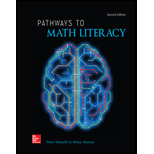
Suppose that the campus in Questions 1—4 is a small satellite campus, with only 400 students. After surveying 180 students (Question 3), almost half of everyone on campus would have been surveyed. The formula for finite population correction is below. Find the value, and in the next question we’ll learn what to do with that number.
Want to see the full answer?
Check out a sample textbook solution
Chapter 4 Solutions
Pathways to Math Literacy
- Question 2: Let A(G) be the set of all automorphisms of a group G. Prove that if G is a group having only two elements, then A(G) consists only of I.arrow_forwardAlready got wrong Chatgpt answer Plz don't use chat gpt will upvotearrow_forwardplease solve this problem step by step and make it quick pleasearrow_forward
- WHAT IS THE CORRECT ANSWER AND WHY?arrow_forwardThis question is a previous exam question. I am using it for practice but am stuckarrow_forwardCHAPTER 1: HISTORY OF COOPERATIVES AND STATE POLICIES Questions for Critical Thinking 1. Discuss the different stages in the history of the Philippine cooperative movement 2. What do you think is meant when it is stated that "one cause for the failure of cooperatives is due to non-patronage by coop members? 3. When the principle of subsidiarity is followed, what are the different manifestations of this principle? Explain. 4. Cooperatives can promote social justice in Philippine society according to the declared policy of the state on cooperatives. Why and how? 5. Why is the recognition of the nature of man neccessary in the success of the cooperative movement? 6. The interest on capital in coops is limited but there is no such limitation in corporation. Explain. 7. How is government intervention proscribed in the declared policies of the government under the present Cooperative Code. 8. Cooperatives grant patronage refund, which is not present in corporations. How do you explain this…arrow_forward
- Already got wrong Chatgpt answer Plz don't use chat gptarrow_forwardT1 T₂ T7 T11 (15) (18) 8 (12) (60) 5 T3 T6 12° 5 5 5 T8 T10 T4 (25) T5 To 1. List all the maximal paths and their weights for the graph above. 2. Give the decreasing-time priority list. 3. Schedule the project using 2 processors and the decreasing-time priority list.arrow_forwardHorizontal cross-sections of the vector fields F⃗ (x,y,z) and G⃗ (x,y,z) are given in the figure. Each vector field has zero z-component (i.e., all of its vectors are horizontal) and is independent of z (i.e., is the same in every horizontal plane). You may assume that the graphs of these vector fields use the same scale. (a) Are div(F⃗ ) and div(G⃗ ) positive, negative, or zero at the origin? Be sure you can explain your answer. At the origin, div(F⃗ ) is Choose At the origin, div(G⃗ ) is Choose (b) Are F⃗ and G⃗ curl free (irrotational) or not at the origin? Be sure you can explain your answer. At the origin, F⃗ is Choose At the origin, G⃗ isarrow_forward
 Glencoe Algebra 1, Student Edition, 9780079039897...AlgebraISBN:9780079039897Author:CarterPublisher:McGraw Hill
Glencoe Algebra 1, Student Edition, 9780079039897...AlgebraISBN:9780079039897Author:CarterPublisher:McGraw Hill Holt Mcdougal Larson Pre-algebra: Student Edition...AlgebraISBN:9780547587776Author:HOLT MCDOUGALPublisher:HOLT MCDOUGAL
Holt Mcdougal Larson Pre-algebra: Student Edition...AlgebraISBN:9780547587776Author:HOLT MCDOUGALPublisher:HOLT MCDOUGAL College Algebra (MindTap Course List)AlgebraISBN:9781305652231Author:R. David Gustafson, Jeff HughesPublisher:Cengage Learning
College Algebra (MindTap Course List)AlgebraISBN:9781305652231Author:R. David Gustafson, Jeff HughesPublisher:Cengage Learning- Algebra & Trigonometry with Analytic GeometryAlgebraISBN:9781133382119Author:SwokowskiPublisher:Cengage
 Functions and Change: A Modeling Approach to Coll...AlgebraISBN:9781337111348Author:Bruce Crauder, Benny Evans, Alan NoellPublisher:Cengage Learning
Functions and Change: A Modeling Approach to Coll...AlgebraISBN:9781337111348Author:Bruce Crauder, Benny Evans, Alan NoellPublisher:Cengage Learning




